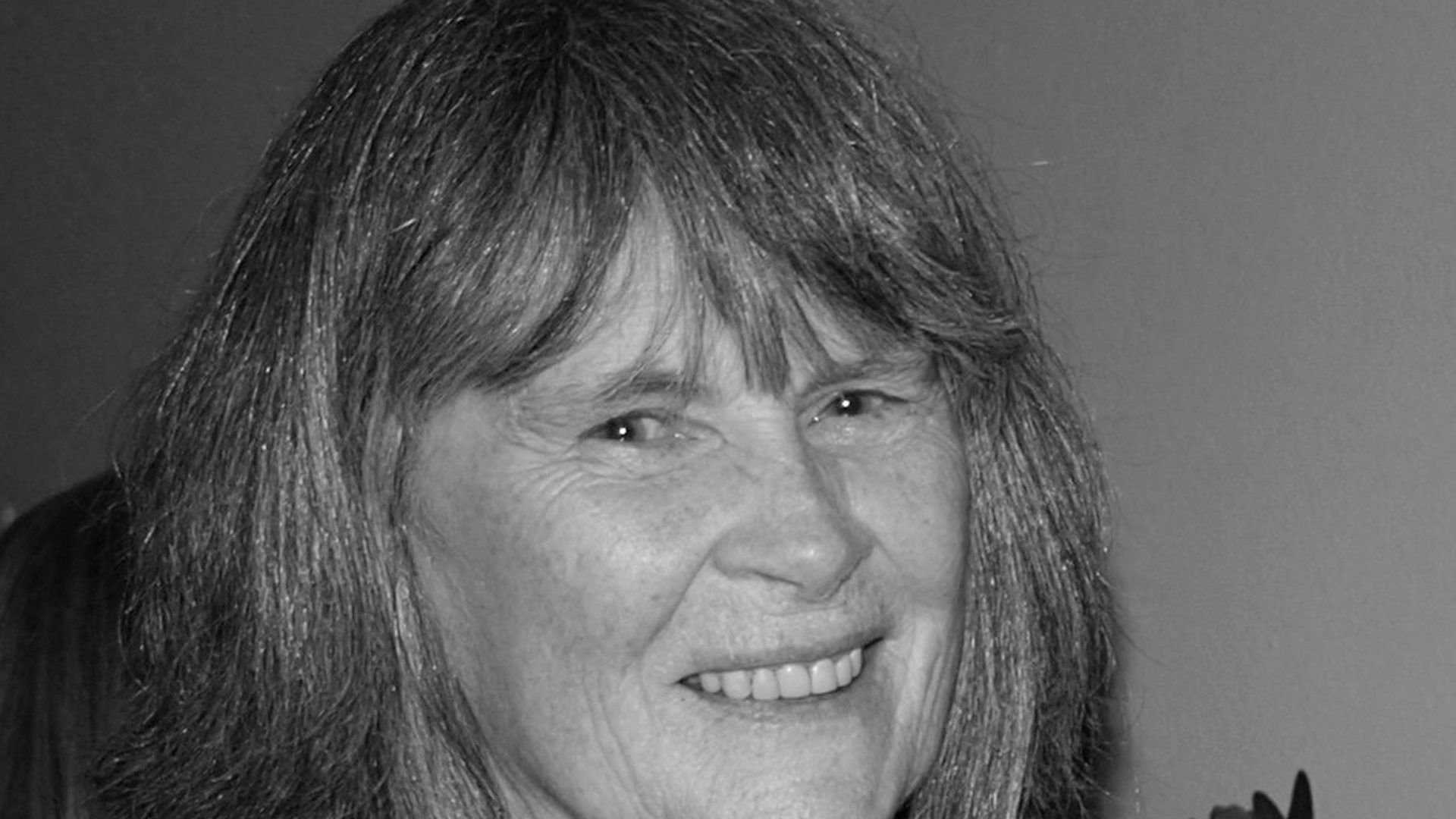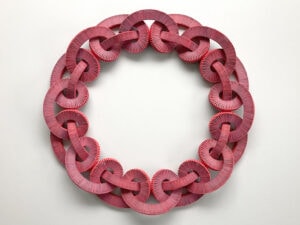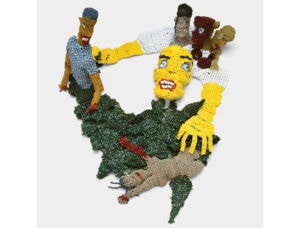Damian Skinner and Kevin Murray, Place and Adornment: A History of Contemporary Jewellery in Australia and New Zealand. Auckland: David Bateman Ltd, 2014.
ISBN: 0824846877
After seven years of collaborative research, Place and Adornment: A History of Contemporary Jewellery in Australia and New Zealand is now published, written by Damian Skinner from Aotearoa New Zealand and Kevin Murray from Australia. Both are well-known authors and each has a specific knowledge of contemporary jewelry, with considerable related experience in other crafts fields.
Kevin Murray has evolved as an advocate for the idea of “the South,” drawing together crafts projects in countries in the southern hemisphere, and is a resilient arguer for the values of retaining connections with the Asia-Pacific section of the World Crafts Council. His most recent exhibition was Joyaviva: Live Jewellery Across the Pacific, with work from Australasia and Latin America, in 2012. He maintains many self-generated online projects and international collaborations, while also being an adjunct professor at RMIT University in Melbourne. Damian Skinner is curator of applied art and design at the Auckland War Memorial Museum Tāmaki Paenga Hira. Along with his experience in writing about the crafts, particularly jewelry, he has a strong parallel background in considering the relationship between customary and modern Māori art in the 20th century and has recently been researching the role that indigenous and “settler” artworks have played in the process of decolonization. Art Jewelry Forum followers will remember him as AJF’s former editor, and he recently edited Contemporary Jewelry in Perspective (Lark Crafts, 2013).
From their separate but related backgrounds, Skinner and Murray have developed distinctive personal points of view and approaches toward their fields of interest. Consequently, while attending a crafts symposium in Auckland in 2008 and hearing their very different proposals for working together on a jewelry publication as a cross-Tasman (known as “across the ditch”) effort, I was quite skeptical about how they could possibly do it. I know them both well. I respect them enormously, but considered they were too independent and too distant from one another to make it work. But they’ve done it! Place and Adornment is an extraordinary hardback volume of around 89,000 words, well-designed, and printed with funding assistance from both Australia and Aotearoa New Zealand.
While the story of contemporary, or studio, jewelry has been the specific subject of, or has been included in, other histories of the crafts in Australasia, this is the first to discuss jewelry practice in both countries so extensively. Why did the authors decide to bring these histories together? The reasons outlined in the introduction include their interest in the opportunity to account for both similarities and difference through comparative analysis, in order to expand perspectives in, and of, each place. Written as a narrative of the evolution of jewelry-making in both countries, the publication brings together the many complexities of the cultural histories of these neighboring Australasian countries—one large, one small—as represented through specific insights into jewelers and their work. It provides these observations within a framework of initial colonial responses to new locations and indigenous cultures in this southern Asia-Pacific region, followed by the continuing influences of international art and design movements; new opportunities for education and travel; changing attitudes to notions of preciousness, value, and identity, and approaches to interpretation; and evolving considerations of indigenous cultural integrity. Within the text, the authors also make reference to other writers who address similar questions of, for example, the concept of “settler societies” in post-colonial and art histories and the internationalism of modernism in relation to the characteristics of “primitivism.”
The title Place and Adornment indicates their thematic strategy, which they elaborate on in the introduction, explaining their choices of terminology and their objectives. They discuss how they see the idea of “place” as a location comprising elements of environment, history, and cultural forces, and as a “reference point charged with emotion and memory.” And they use the inclusive term “adornment” to acknowledge that contemporary jewelry practice in Australasia has a range of cultural origins. Within this scope, they consider the many issues associated with being taken seriously internationally, where a model or movement from elsewhere can become a universal measure, noting that while seeking independent voices, those working at a distance from what is seen as an acknowledged center can become typecast in an exclusionary way. Jewelry made in these two, now multicultural, societies is discussed in seven chapters organized in chronological periods identified by key characteristics and turning points. They are:
- Antecedents: summaries of indigenous Māori and Aboriginal practices; European settlers and tradesmen; importation of early design styles and values.
- Transplanting Modernism 1960–1975: effects of postwar migration of European metalsmiths; from trade to art form; influence of modernism; development of organizational infrastructure.
- Unleashing the Local, 1975–1980: a critique of preciousness; the use of alternative materials; emergence of a “primitivist ethic”; perceived differences in direction between Australia and New Zealand.
- Hermann Jünger Down Under, 1982: an influential visitor who “affirmed contemporary jewellery in Australasia.”
- Here or There, 1980–1990: evolution of a studio-based model; experimental work around ideas of adornment, body, and social issues; international opportunities for Australians; development of Pacific identity for Aotearoa New Zealand; exhibitions such as Cross Currents (in Australia) and Bone, Stone and Shell (in New Zealand).
- The Return of Jewelry, 1990–2000: alternatives to a visual arts model; production and personal narratives; reaffirming post-colonial questions; expanding links with Europe for both countries.
- The Promise of Place: what makes jewelry interesting, distinctive, and important; critique of preciousness further evolved to include “poor craft,” DIY, and “relational” practices; contemporary evolution of indigenous practice; summary of purpose, issues, conclusions, and continuing questions.
This is not a picture book. Or a catalog. Or an encyclopedia. It reads as an informed and speculative account of recent and current practice. As the authors say in Chapter 7, it is a “tendentious reading of the field as opposed to a broad survey.” It is very engaging, particularly for those who recognize the histories, the people, the events—and the illustrated works! Alongside detailed “interlocking” case studies of key people, as well as those of selected exhibitions and organizations including cooperatives, specialist organizations, and galleries, more than 200 photographs of examples of jewelry, and some of the people and places mentioned along the way, are interspersed appropriately in the text.
A puzzle for the reader is that instead of offering separate chapters with identified authorial voices, Skinner and Murray have—surprisingly, to me—written the narrative together. Presumably Skinner has provided most of the Aotearoa New Zealand content, and Murray that which is associated with Australia. However, they have clearly worked collaboratively in acknowledging the common and continuing circumstances and influences in each country, as well as elaborating on their specific differences. Significant is the reference to others who have written about Australasian jewelry at different times along the way, as well as the personal accounts of many who are directly part of the story, so that all their voices become part of the exchange. The narrative therefore ends up being a discussion with these people, led by two authors with one voice. And, yes, it works. But I found myself constantly trying to identify the authorial origin, wondering which one to praise, criticize, or question.
Place and Adornment includes many examples of Australasian jewelers who have responded in their own ways to external measurements of value and status, establishing independent positions while bringing a number of influences together to express their ideas. For example, since the 1960s, jewelry and metalsmithing in both countries benefited from skills imported by Europeans and Scandinavians who arrived through post-war migration. This also led to the enhancement of an existing educational infrastructure that enabled Australians in particular, beginning the 1970s, to follow up with further international connections. In Aotearoa New Zealand, this period saw the emergence of a strong interest in working with local materials such as the bone, stone, and shell that had traditionally been used by Māori, and to which migrants also responded. In contrast, I didn’t see any particular reference to the innovative jewelers in either country with experience in hand-skills, but who are now also developing works using 3D printing technologies.
Importantly, the authors identify the increasing involvement of indigenous artists in the contemporary jewelry movement. Since the latter decades of the 20th century, Indigenous Australians have been drawing on their own personal stories and traditions to make contemporary secular expressions of their traditions, often using nontraditional materials, most significantly in acrylic paint on canvas from the early 1970s. Part of this path of contemporary expression has included the use of introduced textile, ceramics, and metalworking techniques, alongside adaptations of carved and woven forms and worn objects using local materials—now including such items as the “ghost nets” washed up on northern beaches. Equally, many Māori and Pacific Islanders continue to pursue contemporary expression of their traditions in new contexts, often now also using alternative materials such as silver, gold, and plastic. (And not all artists, whatever their cultural background, feel obliged to draw on that background in making new work.)
Nonetheless, a number of questions emerge. For me, these revolve around some of the terminology that has been used. I am reminded of concerns expressed elsewhere in AJF about “borrowing” terminology from other research areas that may or may not be appropriate for contemporary jewelry. The terms “settler” or “settler societies” are part of a concept that originally included “colonists” and could now include “migrants,” some many generations on. “Settler” terminology is used by some historians and anthropologists such as Nicholas Thomas[i] to describe both past and present colonial societies, but in my view it still has a 19th-century connotation. In contrast, the new category of “poor crafts” appears to have been invented as a current extension of the historic, resourceful “making-do” ethic and as a contemporary critique of preciousness, for works that might use “alternative,” recycled, or throwaway materials to create works that are identified as of value in different ways. However, it is not widely used and I don’t believe any of the jewelers described in this category would identify themselves as “poor craft” makers.

Above all, I was uncomfortable with the use of the term “primitivism” throughout the book, as a contemporary expression. It has also been used in many ways by historians and anthropologists to describe the engagement that artists and craftspeople may have sought in favoring local materials also used by indigenous people, and in some cases indigenous cultural forms themselves. Since at least the early 20th century, many Australasian artists and designers used indigenous motifs in, for example, textile designs and ceramic decoration. Some were expressing their own acknowledgment of something of value, such as “place,” with which they sought to be associated. Others identified formal or spiritual elements that contributed to an interpretation or critique of modernism, or copied aspects that could be developed as souvenirs. However, along with many other social changes in the latter decades of the century, the use or “quotation” of indigenous motifs was soon criticized as “appropriation.” It was recognized that these motifs represented sacred stories of particular living cultural groups, and should not be used by people outside that specific context. Contemporary artists, including jewelers, now respect this view and, while often continuing to use materials associated with indigenous practice for their own reasons to do with “place” or “identity,” now usually do it without specific reference to indigenous cultural forms.
In my experience, the term “primitivism” has not been used to describe contemporary crafts (and I checked with colleagues), not because of our ignorance of the issue, but because many of the so-called “primitivist” influences are in fact continuing characteristics of cultural groups living firmly in the present, and whom we respect. While the origin and scope of the term is explained in both the introduction and conclusion of this publication, it has also been the subject of considerable review by cultural historians such as Fred Myers.[ii] In my view, the term in this context is misleading and perpetuates what the authors, themselves, are intending to critique. While they use the word throughout the book, it is not until page 230 that they acknowledge it as problematic and, among a number of useful questions for continuing further consideration, suggest a way forward. However, I am cautious of their proposed resolution. Do we need the word at all? They say:
The primitivist path is a fraught one for contemporary jewellery in Australasia. It carries the danger of colonial paradigms, such as the noble savage, that fix indigenous people in the role of exotic other or innocent child. But the radical energies in contemporary jewellery have potential to recover a ‘primitivism without the primitive’.
These reservations aside, Place and Adornment: A History of Contemporary Jewellery in Australia and New Zealand is definitely worth reading. At the outset, Skinner and Murray said they sought “to allow a truly international participation in contemporary jewelry (in which makers from Australia and Aotearoa New Zealand can take part),” and to reveal the richness and diversity of contemporary jewelry such as this as an international phenomenon. As well as being a substantial record of the practices of so many key people, places, and events, their narratives of regional and international connections offer a pattern that many readers in “places” with similar histories and conditions may recognize. The questions the authors have raised in their conclusions can equally be considered in these wider contexts. This publication is a major achievement that I’m sure will contribute to scholarship in this field.
- Nicholas Thomas, Possessions: Indigenous Art, Colonial Culture. New York: Thames & Hudson, 1999.
- Fred Myers, ‘“Primitivism”, Anthropology and the Category of “Primitive Art,”’ in Handbook of Material Culture, Chris Tilley, Susanne Küchler, Michael Rowlands, Webb Keane, and Patricia Spyer, eds. (London: Sage Press, 2006).





